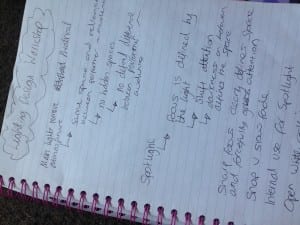Following our first production meeting, LPAC’s stage manager Darren Page invited Emmie and I for an informal chat about lighting and sound. During this talk, I believe the most important advice that Darren gave to us about stage lighting was that the lighting used for each scene had to be used for a reason. Following this talk we were invited to attend a lighting workshop that Darren would be running the following week.
The workshop ran by Darren and his colleague Mark was incredibly helpful. They discussed how different types of light created different types of effects and how that had an impact on the atmosphere of a scene. For example if a scene is lit using ‘top lights’ a sinister atmosphere is created as when an audience ‘cannot see someone’s eyes, it creates a feeling of distrust’ (Page 2015). Darren and Mark also spoke about how the audiences’ focus is defined by the light, in the sense that a lit area on a dark stage indicates to the audience that is where they must look. This is supported by Drew Campbell who states ‘lighting also discriminates between where the show is happening and where it is not’ (2004, p7)
Moving forward from this I intend to sit out of a few rehearsals and make notes on what types of lighting I should use for each scene. I will of course be in conversation with our director Tamsyn to agree on what mood she wants to create for each scene and with Emmie to check that my designs can be applied practically.
(Photo by Clare Owen 2015)
WORKS CITED
Campbell, D. (2004) Technical Theater for Nontechnical People. Second Edition. New York: Allworth Press
Owen, C. (2015) Photo of Lighting Workshop Notes
Page, D. (2015) Lighting Workshop. [workshop] Lincoln, 20 April.
